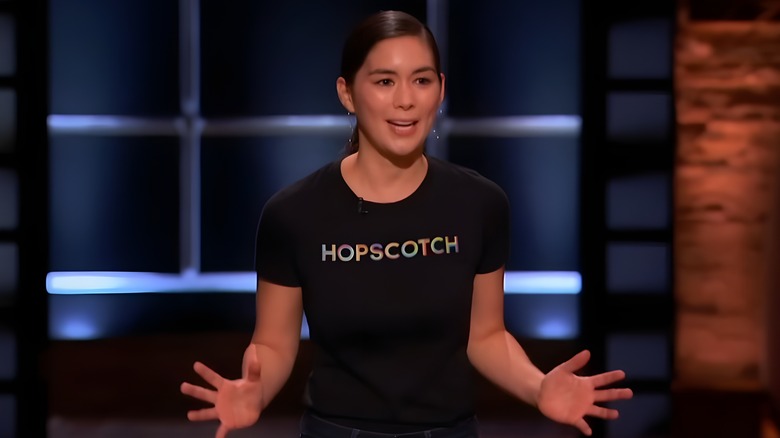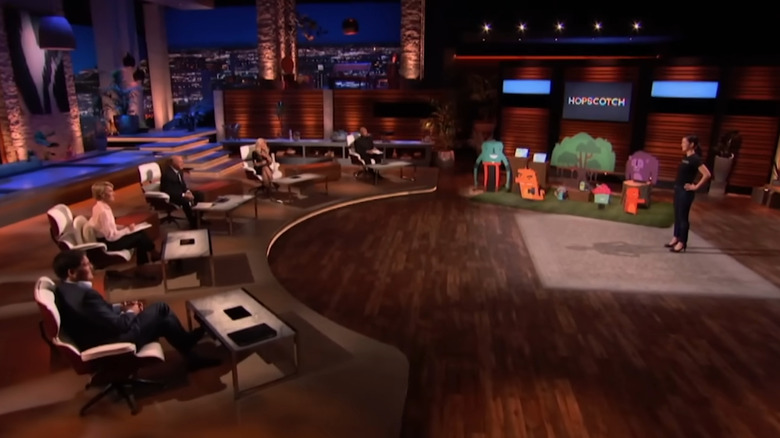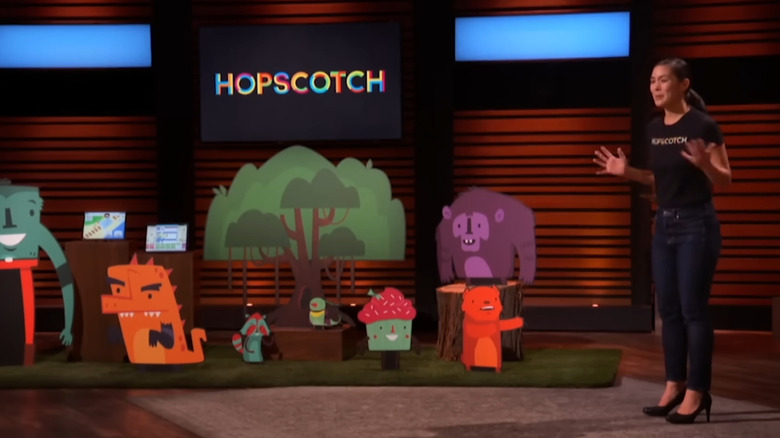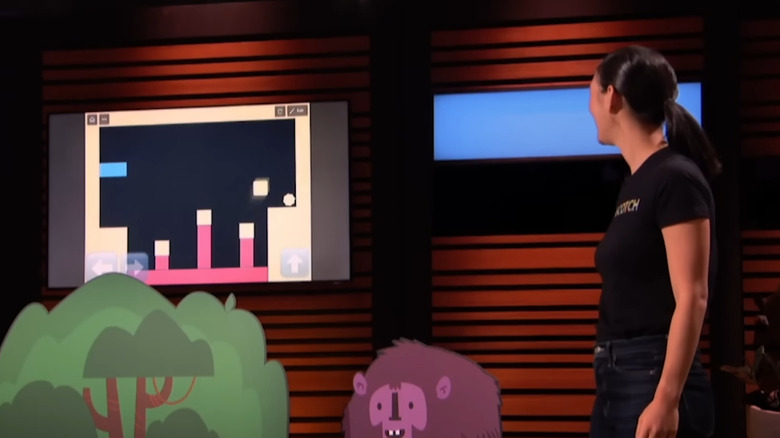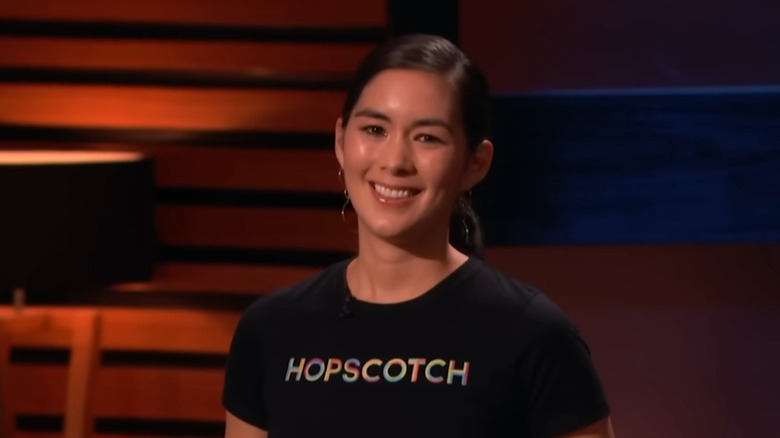Whatever Happened To Hopscotch After Shark Tank?
We may receive a commission on purchases made from links.
Our kids are the future of the business and tech world, so it's crucial that their skills get honed in as early as possible. This is on the forefront of entrepreneur and tech developer Samantha John's mind, whose app Hopscotch has been setting kids on the road of success. Hopscotch allows kids to create high quality games and other programs that they can also sell. On top of honing in valuable business skills, users can also benefit from developing efficiency in coding, game design, animation, and other tools that could help them succeed in their future careers.
John initially didn't give much thought into learning coding until she partook in a computer science class in her final college year. Intrigued by the possibilities of this career path and noticing the lack of women working in the field, John aimed to find an accessible way of teaching kids how to get into programming. She and business partner Jocelyn Leavitt went through different concepts before landing on Hopscotch, which they officially launched in 2013. The app received 20,000 downloads within its debut week and John herself became heralded as a game changer in world of tech. She would be included on several notable lists, including BBC's 100 Women 2015 list, Business Insider's The 30 Most Important Women Under 30 In Tech, and Glamour Magazine's 35 Women Under 35 Who Are Changing the Tech Industry.
Hopscotch was looking to make a difference in the world, but there were hurdles on their path to growth, which led John to make an appearance on "Shark Tank."
What happened to Hopscotch on Shark Tank?
Samantha John came onto Season 12 of "Shark Tank," with her episode airing on February 26, 2021. On the show, she approaches the sharks with an offer of $400,000 for 4% of Hopscotch, with hopes of using the investment to increase their profitability.
John allows the sharks to try out a few of the games and demonstrates how easy it is to start coding in the app. At the time, their business model involves a form of currency that can be bought from the App Store and applied to another game, which Hopscotch keeps part of. Eventually, they want to allow kids to cash out what they earn. After raising capital from prior investment rounds, the company switched to a subscription model of $8 a month. Since then, they've been breaking even and hope a shark can help alter their tactics in a way that will allow the app to be available for free and the currency model to be more prominent.
The panel of investors aren't fully on board with John's plans. While they admire her mission, most of them don't believe that the business model has been thought out substantially enough to go in on. The last one standing is Mark Cuban, who has used Hopscotch with his own kids and even admits to being a fan of what John has accomplished. Recognizing the work it would take to get things moving, he asks for $400,000 for 16% equity — only a quarter of her initial valuation. After some tense negotiating, they settle on a deal for $550,000 for 11% equity.
Hopscotch after Shark Tank
Samantha John's earnest mission with Hopscotch resonated enough with Mark Cuban to score a solid deal on "Shark Tank." Thankfully, he wasn't the only one won over by John's business.
Following the airing of her episode, the team saw the "Shark Tank" effect hit Hopscotch with their usage going up by 500%. This also applied to their subscription service, which saw six times as many individuals subscribing to the app. John realized that telling their story was a big reason for this increase and went on to hire a Head of Growth to aid in spreading their message. John also had no shortage of good things to say about Cuban, stating on an interview with BuzzFeed, "Since 'Shark Tank' aired, Mark is now an investor and I send him updates once a week. He's one of the most involved investors I've ever had. He always replies to my emails, he's always sending me new ideas for Hopscotch. He's so great and I'm so grateful to have him on my team."
In 2022, the company started a new Game Development program. The workshop allowed for a more hands-on approach for students to develop their coding and programming skills with the aid of tutors and personalized lessons. This was the second of Hopscotch's development initiatives following their Seed Developers Program that launched in 2020.
Is Hopscotch still in business?
Users can currently download Hopscotch through the App Store, as well as a web version that can be accessed through their website. Feedback for the app is largely positive. On the App Store, they have over 13,000 reviews with an average rating of 4.5 stars out of five. To date, the app has been downloaded over 24 million times, with 36 million games currently made. Regular app users have a seven day free trial before the subscription starts, indicating that they have yet to break out of this model the way John envisioned on "Shark Tank."
Their website also has resources for parents and educators. Teachers have access to free learning plans that include introductory courses on the topic and plans for how to apply coding to other subjects such as math and social studies. There are also resources available for those wanting to learn more about coding. in 2022, they launched a four part video series about cloning, which gives users an easy way to increase the number of similarly behaving objects within their games. Visitors can also buy merchandise such as t-shirts, stickers, phone cases, and more.
Hopscotch isn't especially active on social media, not having posted on their Facebook, Twitter, or Instagram account since 2022. It's seemed to do little to harm their business, however. As of 2023, they are estimated to have an annual revenue of $5 million.
What's next for Hopscotch?
Hopscotch has made some impressive strides, but like all companies, there are still new heights to reach. The team recently celebrated their 10th anniversary with a YouTube livestream hosted by product manager Yuanyuan Zhao and developer Tracey Le. Much of the video chronicles the company's history and at the end they answered questions. One user asked the team if there is a feature they want to add to Hopscotch that has been difficult to obtain. "Yeah there's probably way too many to go through," Le answers. "But I guess in terms of an existing one that's been quite difficult has been adding Hopscotch to multiple platforms."
They goes on to elaborate that migrating to different platforms has historically been tough for the company, such as when they went from iPads to iPhones. With the app's code base being designed specifically for iOS systems, combined with the small size of Hopscotch's team, they've yet to find a way to make it available for Android users.
Along with being more widespread on different platforms, co-founder Samantha John thinks older users can benefit from the app as well. In a 2019 interview with iMore, John is asked if she sees the app being used for audiences outside of children. She answers, "If we were to do that, our next market would be teenagers ... What we've seen is that kids will start when they're 9 or 10 and now they're 15 and they're still using Hopscotch and they've gotten very good at it." Hopscotch may still have some growing to do, but it seems to be a journey they're excited to take with their aging audience.
"Shark Tank" is available for purchase on Prime Video.
